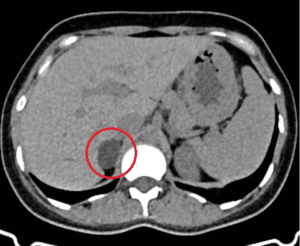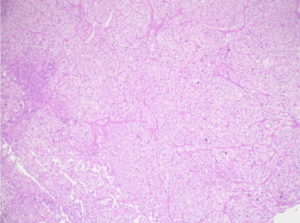Vinay HG1*, Naveen N1, Ramprashanth MP2
1General Surgery, Vamshodaya Hospital, Kolar, Karnataka, India
2MBBS, Vamshodaya Hospital, Kolar, Karnataka, India
*Correspondence author: Vinay HG, MS General Surgery, FSGE, Department of General Surgery, Vamshodaya Hospital, Kolar, Karnataka, India; Email: [email protected]
Published On: 25-12-2023
Copyright© 2023 by Vinay HG, et al. All rights reserved. This is an open access article distributed under the terms of the Creative Commons Attribution License, which permits unrestricted use, distribution and reproduction in any medium, provided the original author and source are credited.
Abstract
Background: Adrenal cortical adenoma with aldosterone hypersecretion, the most prevalent cause of secondary hypertension, represents a significant subset of adrenal tumors with distinct clinical implications.
Clinical Description: A 30-year-old female presented with generalized body pain for two years and multiple episodes of sudden onset progressive weakness of the upper and lower limbs.
Management: The diagnosis was confirmed by serum aldosterone and plasma renin activity and a laparoscopic right adrenalectomy was performed. The histopathology of the removed specimen helped to rule out adrenal cortical carcinoma
Conclusion: A prompt diagnosis and surgical management improves the quality of life for patients with such rare diseases.
Keywords: Young Female; Escape Phenomenon; Generalized Weakness
Introduction
Adrenal cortical adenomas are challenging to diagnose because their clinical presentation ranges from asymptomatic to bizarre symptoms, depending on the excessively produced hormone. Though most of them are usually detected incidentally in radiological investigations, linking such rare diseases to common symptoms can be difficult. Here we describe one such rare case.
Clinical Description
A 30-year-old non-diabetic female presented with generalized body pain and fatigue for two years and sudden onset progressive weakness of the upper and lower limbs for two days. She also gives a past history of similar episodes of bilateral lower limb weakness. On further inquiry, she had no difficulty performing activities involving the proximal group of muscles, clinically ruling out diseases like Myasthenia gravis or Lambert-Eaton syndrome. She also had no recent trauma to the spine. Her menstrual history was regular and normal (for evaluation of blood losses). She was also not on any medication for any chronic illnesses.
On performing a general physical examination, the absence of pallor ruled out anemia in the patient. Her pulse and blood pressure were within normal limits, with a slight increase in the diastolic value. There was no enlargement of the thyroid.
Upon performing the deep tendon reflex (DTR) of the knee, a slight response (1+) was recorded (suggesting fatigued muscle) which decreased the likelihood of cerebrovascular accidents (exaggerated DTRs) and Guillain-Barre syndrome (Normal DTRs).
At this stage, we were unable to reach a diagnosis based only on the clinical features and the patient was requested to perform basic investigations like complete blood count, serum electrolytes, urine routine microscopy and chemistry and a thyroid profile.
Management
The patient came back with reports that showed hypokalemia (2mEq/L). It is suggestive of hypokalemic periodic paralysis due to lack of repolarization in muscle fibres (fatigued muscle after cramps). Incidentally, her TSH was high (7.35 μIU/mL) with low T3 and T4, indicating hypothyroidism. Thus, she was started on oral potassium supplements and levothyroxine (1.6 μg/day/kg body wt). She also had an asymptomatic urinary tract infection which was evidenced by the presence of pus cells and bacteria on the urine microscopy and was treated with a combination of Trimethoprim and Sulphamethoxazole.
Though she was symptomatically feeling much better, the cause for low potassium values was yet to be found. An ECG was performed but was normal. An arterial blood gas analysis was done to measure the blood pH. It showed hypokalemic metabolic alkalosis. The following differentials were thought of Table 1.
|
Differentials |
Primary Pathology |
Salient Features |
Purpose for Rejection |
|
Syndrome of adrenal apparent mineralocorticoid excess |
Absolute deficiency of 11-beta dehydrogenase |
High levels of cortisol, with reduced aldosterone hypokalemia with alkalosis |
Absence of hypernatremia |
|
Glucocorticoid remediable aldosterone |
ACTH stimulating Zona Glomerulosa of Adrenal cortex |
Increase in aldosterone levels. Renin is decreased or normal |
No family history of similar complaints and absence of resistant hypertension |
|
Liddle’s syndrome |
Increased functioning of ENaC due to decreased interaction of EnaC with NEDD -4, causing lesser degradation |
Both aldosterone and renin are decreased |
Normal Renin value with elevated aldosterone (55.1 ng/dL) |
|
Aldosterone secreting adenoma |
Adenoma with hypersecretion of aldosterone |
Increased levels of Aldosterone with decreased renin. |
Potential differential |
Table 1: Differential diagnosis.
Ultimately, the cause behind chronic hypokalemia was confirmed to be an aldosterone-secreting adrenal tumor. The patient was immediately investigated with a CT scan of the abdomen (Fig. 1,2) which showed the following important features:
- A well-defined smooth marginated contrast-enhancing lesion of size 22x20x15 mm in the right adrenal gland
- Features suggestive of adrenal adenoma – absolute washout of 84% and relative washout of 64%
- A normal left adrenal (ruling out bilateral tumors)
The patient was then prepared for laparoscopic right adrenalectomy under general anesthesia (Fig 3,4). The patient was placed in supine with 80° lateral decubitus position with right side facing up. After peritoneal access using 4 ports, right triangular ligament is completely mobilized and the liver is rotated anteromedially. Open book technique was employed and methodical dissection of the right adrenal was carried out, from superior to inferior. The Right adrenal vein is identified and ligated. Dissection is carried out along the capsule and the gland is removed in-toto.
Oral feeds were started on day 1 and were well tolerated. The drain was removed on day 3 and was requested to follow up after a week. The histopathology reports (Fig. 5) showed adrenocortical adenoma with the following:
- Gross: 5.5 x 3.5 x 2 cm nodular gray-brown fatty tissue mass with a well-encapsulated lesion measuring 2.6 x 2.5 cm
- Microscopic: Well-encapsulated tumor with nested cells. No features of suggestive adrenal carcinoma were found

Figure 1: Axial cut sections of Abdominal CT.

Figure 2: Axial cut sections of Abdominal CT.

Figure 3: Histopathological report confirming benign tumor.

Figure 4: Intraoperative laparoscopic view during dissection.

Figure 5: Intraoperative laparoscopic view during dissection.
Discussion
An adrenocortical adenoma is a benign tumor arising from the cortex of the adrenal gland. The incidence of adrenocortical tumors is 2 per 10 lakh population, an underestimated value due to increased reporting of incidentalomas [1]. The CT-based prevalence of adrenal incidentalomas is between 0.35% to 1.9%, but a higher value of 2.3% is obtained from autopsies [2].
A low percentage (15%) of incidentalomas show hypersecretion of hormones (cortisol, aldosterone and catecholamines). Among them, 1.5% to 3.3% are aldosterone-secreting adenoma [2].
The following gene mutations of the KCNJ5 (most common), ATP1A1, ATP2B3, CACNA1D and CTNNB1 are implicated in the etiopathogenesis of such tumors. They are more commonly seen in females than males and are usually diagnosed in the late fifties, in contrast to our 30-year-old patient. They are usually unilateral. Metastatic diseases like lymphoma and congenital adrenal hyperplasia should be considered in bilateral adrenal masses [2].
In humans, aldosterone is produced from the adrenal cortex which acts on the principal cells of the nephron, increasing the expression of the eNaC channels. A hypersecretion results in the excess retention of water and sodium. However, due to simultaneous activation of the Renin-Angiotensin-Aldosterone-System (RAAS), clinical features of volume overload like pedal edema and hypertension are typically not seen (escape phenomena) [3].
Suspected cases of aldosterone-secreting adrenocortical adenoma are reliably screened with an Aldosterone-Renin Ratio (ARR). A combination of serum aldosterone levels of more than 180 pg/ml with an ARR of >32 has a specificity of 99.1% for primary hyperaldosteronism. [4] Confirmation of the diagnosis is most commonly done by Saline Infusion Test (SIT). Though plasma aldosterone is used in screening of the disease, it is not the best investigation for confirmation as it is often measured by immunoassays, which can return inaccurate results. The unilaterality of the disease can be established by Adrenal Venous Sampling (AVS) [5].
Radiological investigations like MRI or CT of the abdomen can be performed to localize the tumor. MRI techniques offer poor sensitivity for characterizing adenoma. Most of the adenomas are hyperintense on in-phase imaging and hypointense on opposed-phase of MRI imaging.
Application of CT for the diagnosis of adrenal adenomas [6]:
- Non-contrast CT: Lipid-rich adenomas are usually <10 HU intensity. Other lesions mimicking are adrenal hyperplasia, adenoma with coexisting non-adenoma and pheochromocytoma
- Washout CT: performed if lesion >10 HU to rule hemorrhage or calcification
- UCT histogram analysis: can be done instead of washout CT when in doubt
- dual-energy Unenhanced CT (UCT): lesion attenuation values decrease in 50% of adenomas on low peak kilo-voltage (80-kVp) UCT, as compared with those on high peak kilo-voltage (140-kVp) UCT
Adrenalectomy is performed in unilateral cases of adrenocortical adenoma and the patient is generally followed-up with biochemical tests to rule out ectopic adrenal masses. Mineralocorticoid receptor antagonist therapy is initiated in patients with bilateral adrenal adenomas, which is usually continued indefinitely [5]. Histopathology is done for confirming the tumor (as in our case) and to rule out adrenocortical carcinomas.
Conclusion
Despite encountering patients with complicated metabolic and electrolyte disorders within the medical specialty, it is essential for a surgeon to attach an excisable tumor as a possibility in such a presentation. Early diagnosis of adrenal adenomas would eliminate the hazardous long-term effects of primary aldosteronism on patients from hypertension (like increased risk for diabetes mellitus and LV hypertrophy) or electrolyte imbalance (like osteoporosis and arrhythmia). Furthermore, few studies have also shown that surgical management of such cases offers a better QoL (Quality of Life) for patients than other forms of treatment. Hence it is crucial to diagnose and surgically manage such rare diseases accurately.
Conflict of Interest
The authors have no conflict of interest to declare.
References
- Ng L, Libertino JM. Adrenocortical carcinoma: diagnosis, evaluation and treatment. The J 2003;169(1):5-11.
- Mahmood E, Anastasopoulou C. Adrenal Adenoma. 2022. Treasure Island (FL): StatPearls Publishing. 2023.
- Coruzzi P. Escape from the sodium-retaining effects of mineralocorticoids: is there a role for dopamine? J Clin Endocrinol Metab. 1994;78(2):455-8.
- Tzanela M, Effraimidis G, Vassiliadi D, Szabo A, Gavalas N, Valatsou A, et al. The aldosterone to renin ratio in the evaluation of patients with incidentally detected adrenal masses. Endocrine. 2007;32(2):136-42.
- Eisenhofer G, Kurlbaum M, Peitzsch M, Constantinescu G, Remde H, Schulze M, et al. The saline infusion test for primary aldosteronism: implications of immunoassay inaccuracy. J Clin Endocrinol Metab. 2022;107(5):e2027-36.
- Park JJ, Park BK, Kim CK. Adrenal imaging for adenoma characterization: imaging features, diagnostic accuracies and differential diagnoses. The British J Radiol. 2016;89(1062):2015-8.
Article Type
Case Report
Publication History
Received On: 23-11-2023
Accepted On: 18-12-2023
Published On: 25-12-2023
Copyright© 2023 by Vinay HG, et al. All rights reserved. This is an open access article distributed under the terms of the Creative Commons Attribution License, which permits unrestricted use, distribution, and reproduction in any medium, provided the original author and source are credited.
Citation: Vinay HG, et al. Unmasking the Silent Menace: A Case Report of Aldosterone-Secreting Adrenal Cortical Adenoma. J Surg Res Prac. 2023;4(3):1-6.

Figure 1: Axial cut sections of Abdominal CT.

Figure 2: Axial cut sections of Abdominal CT.

Figure 3: Histopathological report confirming benign tumor.

Figure 4: Intraoperative laparoscopic view during dissection.

Figure 5: Intraoperative laparoscopic view during dissection.
Differentials | Primary Pathology | Salient Features | Purpose for Rejection |
Syndrome of adrenal apparent mineralocorticoid excess | Absolute deficiency of 11-beta dehydrogenase | High levels of cortisol, with reduced aldosterone hypokalemia with alkalosis | Absence of hypernatremia |
Glucocorticoid remediable aldosterone | ACTH stimulating Zona Glomerulosa of Adrenal cortex | Increase in aldosterone levels. Renin is decreased or normal | No family history of similar complaints and absence of resistant hypertension |
Liddle’s syndrome | Increased functioning of ENaC due to decreased interaction of EnaC with NEDD -4, causing lesser degradation | Both aldosterone and renin are decreased | Normal Renin value with elevated aldosterone (55.1 ng/dL) |
Aldosterone secreting adenoma | Adenoma with hypersecretion of aldosterone | Increased levels of Aldosterone with decreased renin. | Potential differential |
Table 1: Differential diagnosis.


